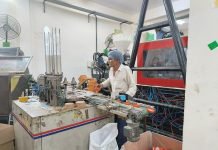JK Paper is on course in its paperboard and corrugated liner capacity expansion plants in the country. Its new paperboard plant in Songadh in Gujarat began production in the second half of 2021 on a new and modern paper machine. For its corrugation liners and corrugated board plant JK was allotted 17-acres of land at a cost of around Rs 40 crore in the Hi-Tech Valley at Ludhiana in Punjab in August 2021. The company’s existing plants are in Raigarh in Orissa and in Songadh in Gujarat.
The paperboard for packaging machines in Songadh has a rated capacity of 170,000 metric tons annually and has been built for Rs 1450 crore or approximately US$ 195.3 million. The company has said it expects to reach 60% capacity in the first four to six months of production and thereafter to reach full capacity. On television, the company’s president and director AS Mehta has suggested that “there is always some hidden capacity and the machine is capable of producing more than 170,000 metric tons.”
The company’s overall paper and board capacity has gone up 625,000 metric tons annually. The new paperboard machine is safely expected to add anywhere from Rs 1,200 to Rs 1,600 crore annually to JK Paper’s turnover depending on raw material and sale prices for the high-quality packaging board that it can produce. It is also planned to export from 15 to 20% of the paperboard produced on the new machine in Songadh.
The company’s consolidated revenue in October to December, Q3 of FY 2021-22 at Rs 1,023 which was its highest ever in a quarter, indicates that the company may be headed for its highest annual revenues. With revenues of Rs 2,600 crore in the first three quarters, the revenue figure should be approximately Rs 3,600 crore for the full FY 2021-22.
Meanwhile, the JK Group’s new unit in Punjab will initially procure waste paper and supply finished goods, which is corrugated packaging paper also known as unbleached liner, and possibly corrugated boards to industries in Punjab and the neighboring states to make corrugated board and cartons. By strengthening the waste paper industry ecosystem in the state, it will help Punjab achieve some of its sustainability goals.
The project will help local manufacturers in sourcing their packaging materials and it is hoped that a large proportion of the plant’s production will be consumed in the state, enhancing its GST revenue collection. JK Paper’s plans were to construct its plant and go into production within a year which means it could be commissioned in Q2 of the 2022-23 financial year.











